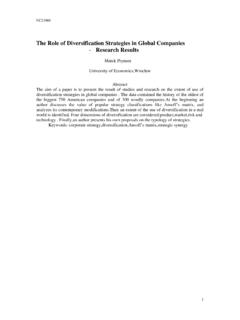Transcription of Rewiring electronics - IBM
1 IBM Global Business Services IBM Institute for Business Value electronics Rewiring electronics Discovering strategies for sustainable growth from a business ecosystem perspective IBM Global Business Services, through the IBM Institute for Business Value, develops fact- based strategic insights for senior business executives around critical industry-specific and cross-industry issues. This executive brief is based on an in-depth study by the Institute's research team. It is part of an ongoing commitment by IBM Global Business Services to provide analysis and viewpoints that help companies realize business value. You may contact the authors or send an e-mail to for more information. Contents Introduction 1 Introduction electronics represent a growing value add for today's product markets, but 1 In search of profitable growth electronics companies seem reluctant to choose what appears to be the most 3 The limits of traditional promising growth strategy: diversification with new products into new markets.
2 An strategies ecosystem analogy can help electronics companies better understand how they can interact with each other to surface new opportunities, ease entry into new 6 Breakthrough growth markets and achieve sustainable growth. Strategies based on innovation rather potential through diversification than domination can enable growth of the entire ecosystem and the companies that comprise it. By taking the ecosystem view, global electronics companies can 7 Diversification in new markets with new products: the capture new growth by focusing on markets where electronics products are a core ecosystem view value add. 10 Assessing the health of In search of profitable growth electronics ecosystems In the 2004 IBM Global CEO study, electronics executives cited growth as the 11 Adapting the business top priority for their Respondents overwhelmingly considered profitable model to find and support an growth (revenue growth paired with cost reduction) to be the primary key to ecosystem role success (see Figure 1).
3 But IBM research also indicates that they tend to rely on 12 An ecosystem health check: the traditional strategies of market penetration, product development and market the telecom electronics development to achieve growth. As Figure 2 shows, diversification growing with ecosystem new products in new markets ranked lowest among perceived strategic oppor . 14 Leveraging the ecosystem tunities for growing revenues. view to realize electronics industry diversification Figure 1. Profitable revenue growth is the key concern of global electronics executives. 15 Managing profitable growth: Revenue growth finding your ecosystem role 16 About the author Cost reduction 16 About IBM Global Business Asset utilization Services 17 References Risk management Effectiveness electronics improvements All industries 0 20 40 60 80 100. Percent Source: Your Turn: The Global CEO Study 2004, IBM Global Business Services.
4 Rewiring electronics IBM Global Business Services Figure 2. electronics executives tend to focus on traditional approaches to achieve growth. New products and services New markets Customer intimacy New channels electronics All industries Diversification 0 20 40 60 80 100. Percent Source: Your Turn: The Global CEO Study 2004, IBM Global Business Services. In interviews conducted by the IBM Institute for Business Value, electronics executives indicated that their reluctance arises from a high perceived risk of pursuing diversification in the wake of recent market downturns. While strategic retrenchment is often an appropriate response to uncertain conditions, over time the urge to avoid risk can take on a life of its own often to the detriment of companies in high-turnover markets like electronics . One of the challenges for Indeed, analysis by IBM shows that playing it safe is not a winning strategy in today's the industry is that we have electronics marketplace.
5 The rate of electronics industry revenue growth has been a tendency to become risk- falling since the end of the late-1990s boom era and is not expected to rebound in the coming years. The telecom industry provides one example. As seen in Figure 3, averse. You must take risks, after growth spikes in 2000, electronics companies within the telecom industry value think out of the box and not chain from telecom equipment providers to semiconductor manufacturers are in accept incrementalization. most cases stagnant or even suffering declining revenue growth. That's been the strength of this industry. I'm concerned Figure 3. Today's common strategies yield limited success in meeting growth and industry leadership objectives. that people have become more conservative because 60 Communication equipment manufacturers EMS. 50. of the last three years. ODM. Percent revenue growth 40 Semiconductor Ned Barnholt, President and Semiconductor capital equipment 2 30.
6 CEO of Agilent Technologies 20. 10. 0. 2000 2001 2002 2003 2004 2005 2006 2007 2008. -10. -20. -30. -40. -50. Source: IBM Institute for Business Value analysis of public company information. Rewiring electronics IBM Global Business Services The limits of traditional strategies In short, electronics companies are failing to pursue the full range of growth oppor . tunities available to them. Analysis by IBM suggests that this problem stems from over-reliance on traditional approaches to expanding the business (see Figure 4). Of the four classic growth strategies laid out by business theorist Igor ansoff ,3 today's electronics companies tend to focus too heavily on the three most traditional market penetration, market development and product development while largely ignoring the fourth: diversification. A brief review of ansoff 's matrix can shed light on how this strategic imbalance is limiting the growth of electronics markets.
7 Figure 4. Most electronics companies leverage only three of ansoff 's four growth strategies. New Product development Diversification Grow new Grow with new products in the products in new same market markets Products Market Market penetration development Grow market Grow with same share with same products in new products in the markets same markets Old Old New Markets Source: Adapted from ansoff , H. Igor. Strategies for Diversification. Harvard Business Review, 1957. Market penetration With the market penetration strategy, companies try to increase market share for existing products in mature markets. A competitive mainstay of the electronics market, this approach succeeds or fails based on a company's ability to improve established products, lower prices or both. The shortcoming of market penetration is that it does little to mitigate the historical volatility and thin profit margins of the electronics industry.
8 Demand for semiconductors, for example, can swing wildly through a single cycle by several orders of magnitude beyond the change in global GDP in most And with profit margins at 5 percent or lower in most segments of the electronics market, electronics companies are left with scant resources to invest in product improvement. Rewiring electronics IBM Global Business Services Market penetration depends heavily on the ability of constant process innovation to beat the entire market. For example, many companies in the semiconductor industry compensate for high fixed innovation costs by concentrating on high-volume products to realize a high return on R&D investment. But this starkly links profit-per- unit to sales volume. To grow, a semiconductor maker must gain ground against rivals in an established market never an easy task or cut non-R&D costs, which offers limited opportunity for boosting margins.
9 There is a high correlation Reliance on market penetration presents particular problems for electronics between market share companies during periods of difficulty. If a struggling semiconductor maker is forced and profitability. to cut R&D costs, for example, the move can quickly reduce the competitiveness of Dominik Asam, Infineon Senior its products. With a growth strategy limited to existing products and markets, this sets Vice President, Investor Relations, up a vicious cycle whereby declining innovation further erodes market share. 5. M&A and Ventures Market development The second strategy, market development, relies on companies pushing existing products in new industries and geographical markets. As globalization continues apace, this strategy is considered imperative among electronics companies. In Your Turn: The Global CEO Study 2004, conducted by IBM Global Business Services, more than 70 percent of electronics industry respondents cited entry into low-cost countries and new market opportunities as top Chinese companies often But like market penetration, the market development strategy is not without short.
10 Use low prices to try to break comings. Global entrants into emerging markets face stiff competition, both from each into overseas markets. Even if other and from established local players. In China, for example, companies like TCL. they do not win any business, and Haier are the setting the pace and taking market share from Western they end up affecting prices in Moreover, as electronics companies crowd into new markets, competition among these markets.. established global brands and local companies drives prices down. 8. Niel Ransom, Alcatel CTO. Downward price pressure from global sourcing has cut into Nokia's profits over the past year as it reduced prices to maintain global market share. The company relied on China and Latin America for growth, even as its share of the traditional European market declined. As a recent article noted in The Wall Street Journal, Nokia paid a price for restabilizing its market share quarter-on-quarter with lower average 9.












